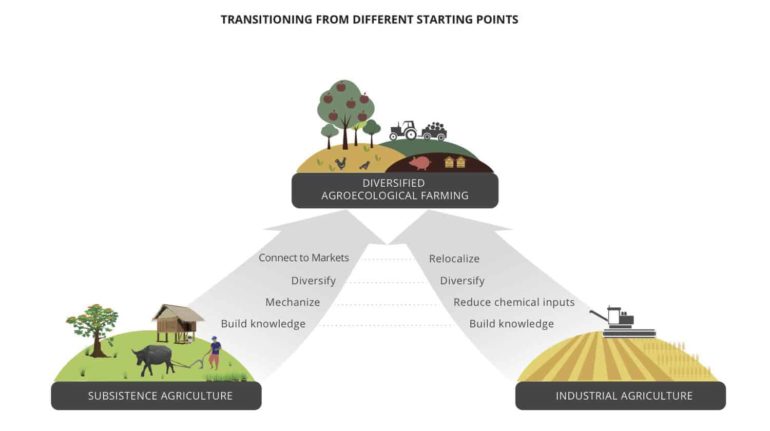Contrary to what we often hear, it is not a lack of evidence holding back ecological alternatives in food systems. It is the mismatch between their huge potential to remedy the problems caused by industrial agriculture, and their much smaller potential to generate profits for agribusiness firms.
Many of the key problems in food systems are linked specifically to industrial agriculture: uniform crop monocultures relying on chemical fertilizers and pesticides, and industrial feedlots (the infamous ‘CAFOs’) that use preventive antibiotics and generate major pollution problems.
The evidence is now overwhelming: industrial agriculture is a key contributor to the rampant biodiversity losses now threatening the 35 percent of global crops dependent on pollination, the degradation of some 20 percent of global land, the 30 percent of global greenhouse gas emissions arising from food and farming, and many other negative outcomes in food systems.
Thanks to the work of campaigning groups and scientists, these problems are now increasingly understood. However, we are much less familiar with a set of equally important facts and figures about the potential of ecological farming to remedy these problems.
The report just released by the International Panel of Experts on Sustainable Food Systems (IPES-Food) synthesizes the growing evidence on this front, for example:
- A 30-year study shows that average organic yields are generally equivalent to conventional agriculture, and 30 percent higher in drought years;
- Total outputs in diversified grassland systems are 15-79 percent higher than in monocultures;
- Resource efficiency is 2 to 4 times higher on small-scale agroecological farms;
- 15 percent more biodiversity has been found in diversified agriculture, and 30 percent more wild species on organic farms;
- Organic meat and milk provide around 50 percent more beneficial omega-3 fatty acids than their conventional equivalents.
To suggest that agroecological farming can improve on the outcomes of industrial agriculture is to understate the case. Agroecological systems are showing major potential to keep carbon in the ground and to restore degraded land – questions to which industrial agriculture has failed to provide any sort of answer. Nor is there a trade-off with food security, as has often been assumed.
In other words, claiming that there is no alternative to industrial agriculture is no longer viable in 2016.
However, as indicated at the outset, the facts alone will not suffice. The way food systems are currently structured allows value to accrue to a limited number of actors, reinforcing their economic and political dominance, and thus their ability to set priorities in food systems.
Power imbalances can no longer be a footnote in discussions about food systems reform.
Identifying these power imbalances and how they lock industrial agriculture in place is just as important as showing the positive impacts of agroecology.
For example, the way we define food security and the way we measure success in food systems tends to reflect what industrial agriculture is designed to deliver – not what really matters in terms of building sustainable food systems. Measuring the yields of specific crops, or productivity per worker, tends to favour large-scale industrial monocultures and to under-value the benefits of alternative systems. These include higher total outputs taking all crops cultivated in combination; greater resilience to shocks; more diversity resulting in improved nutritional quality; and the provision of ecosystem services on and off the farm.
Other barriers arise from the way decision-making takes place. For example, agricultural ministries, committees, and lobbies retain a privileged position relative to other constituencies (e.g. environment, health) in setting the priorities – and allocating the budgets – for policies affecting food systems more broadly. Meanwhile, increasingly privatized agricultural R&D programs remain focused on the handful of crop commodities for which there is a large enough market to secure significant returns.
In other words, the solutions offered by industrial agriculture have been able to remain at center stage, even as the need to reconcile productivity growth with other concerns has been increasingly recognized.
Food systems can be reformed and refocused around diversified agroecological systems. Indeed, change is already happening. Industrial food systems are being challenged on multiple fronts, from new forms of cooperation and knowledge-creation to the development of new market relationships that bypass conventional retail circuits.
However, if these initiatives are to emerge beyond the margins, the vicious cycles keeping industrial agriculture in place must be broken. IPES-Food has identified what some of those steps might look like. In particular, we must address the political economy of food systems: who decides, on the basis of which information, and under which set of influences.
There is no single script to be followed: the pathways to agroecological farming and sustainable food systems will take a variety of forms. That, after all, is inevitable, once we recognize that the steps towards diversified agroecological farming are steps to democratize decision-making and to rebalance power in food systems.
IPES-Food’s first major report ‘From Uniformity to Diversity: a paradigm shift from industrial agriculture to diversified agroecological systems’ was released today – see the executive summary and full report. Olivier De Schutter is the co-chair of IPES-Food and former UN Special Rapporteur on the right to food. Emile Frison, former Director General of Bioversity International, is a member of IPES-Food and the lead author of this report.






